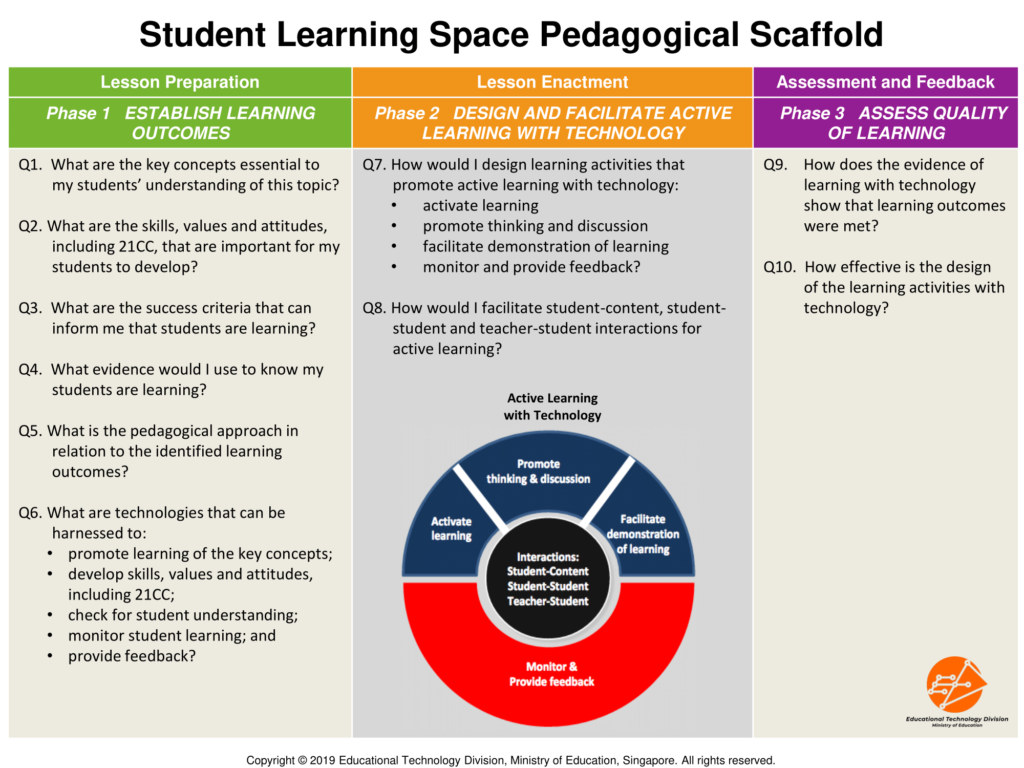The Student Learning Space Pedagogical Scaffold was designed and rolled out just as I joined the Learning Partnerships in Education Branch. I was involved in some of the training sessions such as the SLS Design Challenge in 2018 where it was shared with all the schools in Singapore. After 4 years, I am about to co-facilitate training with it again – this time, with version 2.0 and with our school’s teachers on its use.

Here are some quick thoughts that I wanted to jot down before that happens and that I will try to refine along the way.
- What is the SLS PS? It includes a series of questions intended to help both beginning teachers and experienced teachers think about how “active learning with technology” can be achieved. Breaking that phrase down down: active learning is where students are actively engaged in sense making as opposed to didactic teaching where the only input is auditory or visual. Done with technology if it serves us well, this means technology is optional. Despite the name, the SLS PS need not be done with SLS as well! But instead it encourages us to consider it in light of all the other tools out there to see which tool best serves our purpose.
- One thing we kept emphasising was to make success criteria explicit:
- To promote metacognition (i.e. students will also know if they learnt)
- Helps us not to over-plan. Squeezing too many SCs in one lesson would make it difficult to assess if students are learning.
- SCs are more than just SIOs from the syllabus document, but specific performance goals that can be observed by both learner and instructor.
- Even though the SLS PS’s Learning Experiences are named after Diana Laurillard’s 6 LEs, The “LE”s in the SLS PS work toward a lesson/unit/topical plan, each with a “flavour” or a main mode of teaching. The components of this plan would include different combinations of the following types of activities, meant to:
- Activate Learning
- Promote Thinking and Discussion
- Facilitate Demonstration of Learning
- Monitoring and Providing Feedback
- Therefore, a learning activities found inside an “Acquisition” lesson plan can be a “Discussion” or “Practice” activity as well.
- The Design Map gives everyone a visual overview of the timeline, types of activities, and level of interaction while highlighting the technology or resources used. This is mainly used for lesson sharing.
- One main purpose of the PS is to allows us to consider the key applications of technology, namely:
- Personalisation through fostering student agency, giving choice in the learning goals, process and pace through digital resources
- Differentiation through harnessing the interactivity and multimodal features of digital technologies to differentiate the
- nature of content,
- learning processes and
- products of learning
- Conceptual Change through multimodal representations of abstract concepts, allowing students to discern critical features, and patterns, and infer generalisations.
- Scaffolding in the digital learning environment to support thinking and guide interactions between students, teachers and content.
- Learning Together (collaborative learning) by integrating supports for students to collectively improve their ideas over time by sharing, building on, organising, and synthesizing their knowledge and developing understandings.
- Metacognition by integrating automated supports for students to make sense of and regulate their learning activities and group knowledge, and articulate their reflection through multiple modes.
- Assessment for Learning by capturing and analysing assessment data to provide a student- or group-targeted feedback about their level of understanding, learning processes and progress and resources for students to access an expert’s conceptual organisation and modulate their actions.